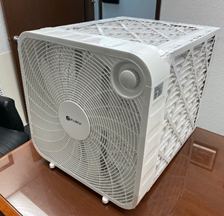DIY air purifier fights indoor air pollutants
January 19, 2023
Using a do-it-yourself air purifying device, a UT professor emeritus created an efficient yet cost-effective way to clean air in compact environments like dorms, apartments and lecture halls.
The Corsi-Rosenthal box was developed in August 2020 by Richard Corsi, a professor emeritus in the department of civil, architectural and environmental engineering, and Jim Rosenthal, chairman and CEO of Tex-Air Filters. All that is needed to build the box are MERV 13 filters, a box fan, scissors, cardboard for the bottom of the box and tape to adhere the fan and filters together.
“Very simply, it is four or five MERV 13 air filters taped together and taped to a box fan, and then there is a shroud added to it to enhance the performance,” Rosenthal said. “If you can tape a box to send to UPS, you can make one of these.”
Pawel Misztal, an assistant professor in the department of civil, architectural and environmental engineering, said the most efficient way to purify indoor air is to mix it with outdoor air.
“For indoor air quality, it’s important to realize that oftentimes dilution is the solution to pollution,” Misztal said.
However, for smaller environments like dorms and apartments, where it may be difficult to ventilate the space, Misztal said air purification devices provide a suitable alternative.
“It really makes the dorm room much safer and reduces particle counts dramatically,” Rosenthal said. “It dramatically improves or decreases infectious dose.”
The effectiveness of an air purifier is measured through a few different quantities: filter efficiency (how much the filter captures) and flow-rate (how much air passes through the filter).
Multiplying filter efficiency and flow-rate gives the clean air delivery rate. Mistzal said the Corsi-Rosenthal box far exceeded the values found in air purifiers currently sold.
“It works better in many cases than a HEPA filter,” Rosenthal said. “The CDC did an extensive study of box fans and air filters and found that the Corsi-Rosenthal box was the most effective, and it can reduce particle counts in rooms by up to 73%.”
The HEPA filter, according to the Environmental Protection Agency, can remove 99.97% of particles like dust or pollen. Rosenthal said in a test against HEPA filters, the Corsi-Rosenthal box exceeded it.
“There are a few recent papers from colleagues that … evaluated Corsi-Rosenthal boxes and they reported CDARs exceeding 600 (cubic feet per minute),” Misztal said. “That’s actually pretty amazing given that anyone can take filters … and add the fan, and it should basically work quite efficiently and at low cost.”
Rosenthal said the box is just one of the steps society can take to prioritize clean air in public spaces.
“Improving indoor air quality is essential to getting ahead of these communicable diseases,” Rosenthal said. “When we drank water that’s contaminated 100 years ago, we figured out that’s why we got typhoid. So, we started cleaning water, and it’s the same thing with air. We are living in environments where we need to be cleaning the air.”



